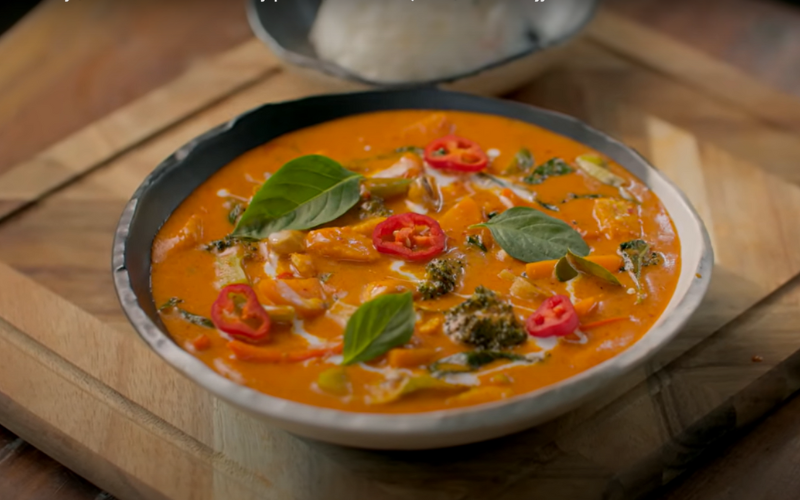Ingredients
Method
Recipe for Preparing Red Curry Paste
- Toast coriander seeds, cumin seeds, and white pepper in a dry pan, then grind them into a fine powder using a mortar and pestle or a mixer grinder for convenience.
- Transfer the ground spices to a separate bowl and set aside.
- Add the chopped lemongrass, galangal, kaffir lime leaves, garlic, shallots, coriander stems and roots, and finely chopped lemon peel to the mortar/ grinder.
- Sprinkle a pinch of salt and start pounding/ grinding all the ingredients into a coarse paste.
- Roughly chop the soaked red chilies, add them in, and continue grinding until the mixture becomes a smooth, consistent paste.
- Finally, add the reserved powdered spice mix and pound/ grind briefly again to blend everything well.
- Your Thai Red Curry Paste is ready! Use half the quantity for one curry preparation.
Recipe to Prepare Thai Red Curry
- Heat a wok over high flame and pour in 100 ml of coconut milk. Bring it to a gentle boil.yg
- Add half of the prepared Thai red curry paste, stir well, and cook over medium-high heat until the mixture releases its natural oils.
- Pour in the remaining 400 ml coconut milk along with a little water, stir to combine, and bring the curry back to a boil.
- Add baby corn and cook for 3–4 minutes until partially tender.
- Add the rest of your chopped vegetables (like bell peppers, carrots, zucchini, etc.) and boil for another 2–3 minutes on high flame.
- Taste the curry and adjust the seasoning. Add palm sugar/ brown sugar to balance the flavours — increase the quantity if you prefer it slightly sweeter.
- Stir in fresh basil leaves and kaffir lime leaves, and let the curry simmer for another 1–2 minutes.
- Finally, add fresh red chillies as garnish or for an extra spicy kick.
- Your rich, fragrant, and comforting Thai Red Curry is ready to serve!
Notes
-
Coconut Milk Tip:
Use full-fat coconut milk for a richer and creamier curry. If you prefer a lighter version, you can use a mix of full-fat and light coconut milk. - Cooking Tip:
Do not overcook the veggies. Let them be crunchy and chewy. -
Vegetable Choices:
Feel free to use any combination of vegetables like bell peppers, carrots, zucchini, broccoli, mushrooms, or even tofu. Stir-fried or blanched veggies retain a better texture. -
Protein Add-ons:
To make it heartier, add cubed tofu, paneer, or cooked chickpeas. For non-vegetarian versions, you can add chicken, prawns, or fish fillets. -
Spice Adjustment:
Adjust the number of dried red chilies in the curry paste to control the heat level. You can also deseed them for a milder flavor. -
Sweetness Balance:
Brown sugar balances the heat and acidity of the curry. Taste and tweak according to your preference — jaggery can also be used. -
Lemongrass Alternative:
If fresh lemongrass isn’t available, use lemongrass paste or dried stalks soaked in warm water for 10 minutes before grinding. -
Storage & Freezing:
The curry paste can be refrigerated for 3–4 days or frozen in small portions for up to 2 months. The curry itself keeps well in the fridge for 2 days. -
Serving Suggestions:
Serve hot with steamed jasmine rice, sticky rice, or flat noodles. Garnish with fresh basil or coriander leaves for added aroma. -
Gluten-Free Friendly:
This recipe is naturally gluten-free — just ensure your soy sauce (if added) is gluten-free.
